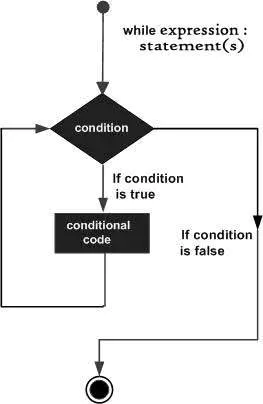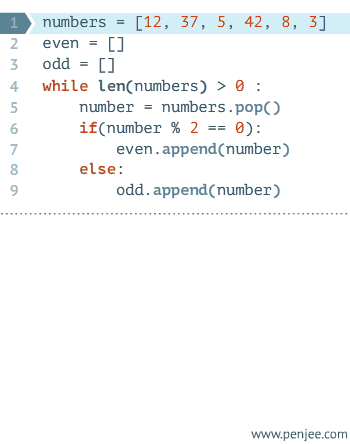您好,登錄后才能下訂單哦!
您好,登錄后才能下訂單哦!
這篇文章主要介紹了Python While循環語句實例演示及原理解析,文中通過示例代碼介紹的非常詳細,對大家的學習或者工作具有一定的參考學習價值,需要的朋友可以參考下
Python 編程中 while 語句用于循環執行程序,即在某條件下,循環執行某段程序,以處理需要重復處理的相同任務。其基本形式為:
while 判斷條件:
執行語句……
執行語句可以是單個語句或語句塊。判斷條件可以是任何表達式,任何非零、或非空(null)的值均為true。
當判斷條件假false時,循環結束。
執行流程圖如下:

Python while 語句執行過程

實例:
#!/usr/bin/python count = 0 while (count < 9): print 'The count is:', count count = count + 1 print "Good bye!"
以上代碼執行輸出結果:
The count is: 0 The count is: 1 The count is: 2 The count is: 3 The count is: 4 The count is: 5 The count is: 6 The count is: 7 The count is: 8 Good bye!
while 語句時還有另外兩個重要的命令 continue,break 來跳過循環,continue 用于跳過該次循環,break 則是用于退出循環,此外"判斷條件"還可以是個常值,表示循環必定成立,具體用法如下:
# continue 和 break 用法
i = 1
while i < 10: i += 1 if i%2 > 0: # 非雙數時跳過輸出
continue
print i # 輸出雙數2、4、6、8、10
i = 1
while 1: # 循環條件為1必定成立
print i # 輸出1~10
i += 1
if i > 10: # 當i大于10時跳出循環
break
無限循環
如果條件判斷語句永遠為 true,循環將會無限的執行下去,如下實例:
#coding=utf-8
#!/usr/bin/python
var = 1
while var == 1 : # 該條件永遠為true,循環將無限執行下去
num = raw_input("Enter a number :")
print "You entered: ", num
print "Good bye!"
以上實例輸出結果:
Enter a number :20
You entered: 20
Enter a number :29
You entered: 29
Enter a number :3
You entered: 3
Enter a number between :Traceback (most recent call last):
File "test.py", line 5, in <module>
num = raw_input("Enter a number :")
KeyboardInterrupt
注意:以上的無限循環你可以使用 CTRL+C 來中斷循環。
循環使用 else 語句
在 python 中,for … else 表示這樣的意思,for 中的語句和普通的沒有區別,else 中的語句會在循環正常執行完(即 for 不是通過 break 跳出而中斷的)的情況下執行,while … else 也是一樣。
#!/usr/bin/python count = 0 while count < 5: print count, " is less than 5" count = count + 1 else: print count, " is not less than 5"
以上實例輸出結果為:
0 is less than 5 1 is less than 5 2 is less than 5 3 is less than 5 4 is less than 5 5 is not less than 5
簡單語句組
類似if語句的語法,如果你的while循環體中只有一條語句,你可以將該語句與while寫在同一行中, 如下所示:
#!/usr/bin/python flag = 1 while (flag): print 'Given flag is really true!' print "Good bye!"
注意:以上的無限循環你可以使用 CTRL+C 來中斷循環。
While循環語句實例
猜拳小游戲
#!/usr/bin/python
# -*- coding: UTF-8 -*-
import random
while 1:
s = int(random.randint(1, 3))
if s == 1:
ind = "石頭"
elif s == 2:
ind = "剪子"
elif s == 3:
ind = "布"
m = raw_input('輸入 石頭、剪子、布,輸入"end"結束游戲:')
blist = ['石頭', "剪子", "布"]
if (m not in blist) and (m != 'end'):
print "輸入錯誤,請重新輸入!"
elif (m not in blist) and (m == 'end'):
print "\n游戲退出中..."
break
elif m == ind :
print "電腦出了: " + ind + ",平局!"
elif (m == '石頭' and ind =='剪子') or (m == '剪子' and ind =='布') or (m == '布' and ind =='石頭'):
print "電腦出了: " + ind +",你贏了!"
elif (m == '石頭' and ind =='布') or (m == '剪子' and ind =='石頭') or (m == '布' and ind =='剪子'):
print "電腦出了: " + ind +",你輸了!"
以上實例輸出結果為:
輸入 石頭、剪子、布,輸入"end"結束游戲:石頭 電腦出了: 石頭,平局! 輸入 石頭、剪子、布,輸入"end"結束游戲:石頭 電腦出了: 剪子,你贏了! 輸入 石頭、剪子、布,輸入"end"結束游戲:
以上就是本文的全部內容,希望對大家的學習有所幫助,也希望大家多多支持億速云。
免責聲明:本站發布的內容(圖片、視頻和文字)以原創、轉載和分享為主,文章觀點不代表本網站立場,如果涉及侵權請聯系站長郵箱:is@yisu.com進行舉報,并提供相關證據,一經查實,將立刻刪除涉嫌侵權內容。